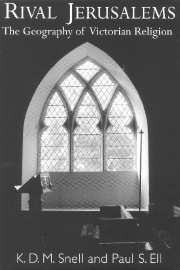Book contents
- Frontmatter
- Contents
- List of figures
- List of tables
- Preface and acknowledgements
- Introduction
- Part 1 Religious geographies: the districts of England and Wales
- Part 2 Religion and locality: parish-level explorations
- 7 A prospect of fifteen counties
- 8 From Henry Compton to Horace Mann: stability or relocation in Catholicism and Nonconformity, and the growth of religious pluralism
- 9 The Sunday school movement: child labour, denominational control and working-class culture
- 10 Free or appropriated sittings: the Anglican Church in perspective
- 11 Conformity, dissent and the influence of landownership
- 12 Urbanisation and regional secularisation
- Technical appendices
- Bibliography
- Index
12 - Urbanisation and regional secularisation
Published online by Cambridge University Press: 08 August 2009
- Frontmatter
- Contents
- List of figures
- List of tables
- Preface and acknowledgements
- Introduction
- Part 1 Religious geographies: the districts of England and Wales
- Part 2 Religion and locality: parish-level explorations
- 7 A prospect of fifteen counties
- 8 From Henry Compton to Horace Mann: stability or relocation in Catholicism and Nonconformity, and the growth of religious pluralism
- 9 The Sunday school movement: child labour, denominational control and working-class culture
- 10 Free or appropriated sittings: the Anglican Church in perspective
- 11 Conformity, dissent and the influence of landownership
- 12 Urbanisation and regional secularisation
- Technical appendices
- Bibliography
- Index
Summary
The growth of ‘secularisation’ is one of the most important subjects of modern history. It has been approached in a great variety of ways, across sociology, politics, anthropology, theology and biblical criticism, the history of ideas and of science, and many other historical sub-disciplines. There is no doubt that a spatial or geographical approach, using the data of this book, can deepen understanding of secularisation. It can do this most obviously by studying the effects of urbanisation upon religious attendance, and by looking at the cartography of low religious attendance to examine what scholars in some countries call areas of ‘de-Christianisation’.
The view that ‘urbanisation’, or a growing proportion of the population living in towns and cities, adversely affected religious belief and attendance in the nineteenth century was for a long time considered almost axiomatic among historians. Indeed, a concern with possible shortcomings of religious provision in larger towns was prominent in the Religious Census itself, as revealed in the summary urban tables that Horace Mann supplied to evaluate ‘spiritual provision and destitution’. The arguments varied, but they included the views that urban parochial supervision was relatively ineffective, that a sense of religious community was destroyed by industrial cities, that urban churches and sittings were inadequate to demographic requirements, that non-agricultural employment was inimical to religious belief and fostered more secular forms of class organisation, and that the pluralistic environment and diverse ideas available to town inhabitants militated against steadfastly held older doctrines.
- Type
- Chapter
- Information
- Rival JerusalemsThe Geography of Victorian Religion, pp. 395 - 420Publisher: Cambridge University PressPrint publication year: 2000



